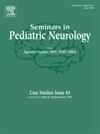AIDS virus
IF 2.1
4区 医学
Q2 CLINICAL NEUROLOGY
引用次数: 0
Abstract
HIV affects both the central and peripheral nervous systems, resulting in a wide range of neurological complications due to direct viral effects, chronic inflammation, opportunistic infections, and adverse effects of antiretroviral therapy (ART), collectively referred to as neuroAIDS. In children, the underdeveloped blood-brain barrier heightens the vulnerability of the brain to neuroAIDS, impacting cognitive and motor development. Even HIV-exposed, uninfected children exhibit neurodevelopmental delays.
Chronic infection leads to a sustained viral presence in the cerebrospinal fluid, resulting in neuroinflammation. HIV encephalopathy (HIVE) remains a major concern, causing developmental regression, cognitive impairment, and motor dysfunction. Although the prevalence of HIVE has declined with the advent of combination antiretroviral therapy, rates remain high in low-resource settings.
Opportunistic infections such as tuberculous meningitis, viral encephalitis, and fungal infections are prevalent among children with HIV-AIDS. Children with HIV are also at risk for cerebrovascular diseases, neurocognitive impairments, and neuropsychiatric conditions such as mood disorders and high-risk behaviors. Epilepsy and peripheral neuropathy are more common in children with HIV, with ART regimens sometimes contributing to neuropathy.
Early ART initiation remains crucial in improving neurodevelopmental outcomes. Careful drug selection and adequate treatment of opportunistic infections before ART initiation are important to prevent drug-drug interactions and immune reconstitution inflammatory syndrome, respectively. While treatment progress has improved neurological outcomes, disparities in access to healthcare continue to impact children in resource-limited settings.
艾滋病病毒
HIV影响中枢和周围神经系统,由于病毒的直接作用、慢性炎症、机会性感染和抗逆转录病毒治疗(ART)的不良反应,导致广泛的神经系统并发症,统称为神经艾滋病。在儿童中,不发达的血脑屏障增加了大脑对神经艾滋病的脆弱性,影响了认知和运动发育。即使是接触艾滋病毒的未感染儿童也表现出神经发育迟缓。慢性感染导致脑脊液中持续存在病毒,导致神经炎症。HIV脑病(HIVE)仍然是一个主要的问题,引起发育倒退,认知障碍和运动功能障碍。尽管HIVE的流行率随着抗逆转录病毒联合治疗的出现而下降,但在资源匮乏的环境中仍然很高。机会性感染,如结核性脑膜炎、病毒性脑炎和真菌感染在艾滋病毒/艾滋病儿童中普遍存在。感染艾滋病毒的儿童也有患脑血管疾病、神经认知障碍和神经精神疾病(如情绪障碍和高危行为)的风险。癫痫和周围神经病变在感染艾滋病毒的儿童中更为常见,抗逆转录病毒治疗方案有时会导致神经病变。早期开始抗逆转录病毒治疗对于改善神经发育结果仍然至关重要。在开始抗逆转录病毒治疗之前仔细选择药物和充分治疗机会性感染分别对预防药物-药物相互作用和免疫重建炎症综合征很重要。虽然治疗进展改善了神经系统预后,但在资源有限的环境中,获得医疗保健方面的差距继续影响着儿童。
本文章由计算机程序翻译,如有差异,请以英文原文为准。
求助全文
约1分钟内获得全文
求助全文
来源期刊

Seminars in Pediatric Neurology
CLINICAL NEUROLOGY-PEDIATRICS
CiteScore
4.80
自引率
0.00%
发文量
38
审稿时长
84 days
期刊介绍:
Seminars in Pediatric Neurology is a topical journal that focuses on subjects of current importance in the field of pediatric neurology. The journal is devoted to making the status of such topics and the results of new investigations readily available to the practicing physician. Seminars in Pediatric Neurology is of special interest to pediatric neurologists, pediatric neuropathologists, behavioral pediatricians, and neurologists who treat all ages.
 求助内容:
求助内容: 应助结果提醒方式:
应助结果提醒方式:


